and the distribution of digital products.
DM Television
Understanding Galxe & Gravity: A Comprehensive Overview
- Galxe is a Web3 Super App powered by Gravity - a high-performance, EVM-compatible Layer-1 blockchain. Galxe’s ecosystem includes products like Galxe Passport, Galxe Quest, Galxe Identity Protocol, Galxe Score, and Alva, which support identity verification, community engagement, and real-time, AI-powered crypto insights.
- In total, Galxe has had 31 million unique addresses interacting with protocols via Galxe Quest, with unique addresses increasing from 2.6 million in Q4’23 to 10 million in Q3’24, a 287% increase.
- Galxe’s Identity Protocol leverages zero-knowledge proofs (ZKPs) to provide self-sovereign digital identities, giving users full control over their data and enabling secure, interoperable verification.
- Gravity, Galxe's Layer-1 omnichain blockchain is expected to launch in Q4’25, with its Alpha Mainnet currently live. It will deliver over one gigagas per second throughput and sub-second finality, powered by its pipelined AptosBFT consensus engine and Grevm (Gravity EVM), a parallel EVM runtime. It will ensure PoS security through restaking technology.
- In July 2024, Galxe DAO approved the upgrade of its utility token from GAL to G, with GAL convertible to G at a 1:60 ratio, and G becoming the native gas token of the Gravity network. At migration, 7.2 billion G (60.3% of the 12 billion total supply) were in circulation.
Centralized companies like Google and Apple have dominated the digital identity sector. According to a social login report from 2022, Google accounted for 75% of all social logins via Auth0, a widely used verification service. Meanwhile, Apple was the second most popular social login method, accounting for 14% of all social logins via Auth0.
While these companies, such as Google, simplify the user experience by allowing people to access several different platforms with one single digital identity, centralization limits the potential of these digital identities. For example, when a user logs in to the ESPN app with their Google account, they can set up a profile on the app and customize it to show the sports and teams they are interested in. However, when this person uses the same Google account to log in to their X account, none of the information related to the user on the ESPN app transfers over to X. Since each of these apps is isolated, the user’s preferences and information must be reentered on each app.
Galxe aims to disrupt the sector with its Web3 alternative, the Galxe Identity Protocol, offering a new approach to digital identities compared to traditional Web2 companies. The protocol utilizes zero-knowledge proof (ZKP) technology to provide identity infrastructure, allowing users to manage and verify credentials securely and privately while giving them complete control over their data. The key difference between the Galxe Identity Protocol and traditional digital identities is that users own their data instead of the company, and it is interoperable with any app that it can connect to.
Additionally, Galxe is launching Gravity, a Layer-1 omnichain blockchain developed to address scalability and efficiency needs. It will deliver over one gigagas per second throughput and sub-second finality, powered by its pipelined AptosBFT consensus engine and Grevm (Gravity EVM), a parallel EVM runtime. It will ensure PoS security through restaking technology. As part of this transition to this new network, Galxe underwent a token migration in July 2024, migrating from the previous GAL token to G. G is intended to be the native token of Gravity that will unite this network and the broader Galxe ecosystem. As of the time of writing, the Gravity Alpha Mainnet is live, with Mainnet expected to launch in Q4’25.
Galxe’s full suite of products include:
- Galxe Quest: A platform for building and engaging Web3 communities through reward-based loyalty programs.
- Galxe Passport: A secure digital identity solution that simplifies online verification, enabling trusted and privacy-preserving exploration of Web3 applications.
- Galxe Score: A reputation system that reflects a user's digital identity based on onchain achievements, engagement, enterprise, and assets.
- Galxe Compass: A hub for users to discover and participate in airdrop campaigns and other reward opportunities within the Web3 ecosystem.
- Alva: An AI copilot designed for Web3 research and exploration. It assists users by providing real-time insights into the Web3 ecosystem, including industry analytics, project information, market trends, and community discussions.
Across these products, Galxe has issued 362,000 credentials, had a total of 31.4 million unique active users who interacted with Galxe Quest, had over 6,500 projects use Galxe to create quests, and amassed 977,000 Galxe Passport holders.
Since its founding in March 2021 by Harry Zhang and Charles Wayn, Galxe has emerged as a leader in decentralized identity infrastructure and Web3’s largest onchain distribution platform, allowing users to build onchain reputations while giving developers tools to attract and retain engaged communities. Launched initially as Project Galaxy, the platform rebranded to Galxe in September 2022 to align with its broader vision and expanding mission.
Galxe has secured funding through multiple investment rounds totaling $25.2 million. In two private growth rounds, Galxe raised a total of $10 million. These rounds were led by Multicoin Capital and Dragonfly Capital, with participation from Spartan Group, Coinbase Ventures, Binance Labs, and others. Additionally, Galxe raised $15 million through a public sale on CoinList in April 2022.
Technology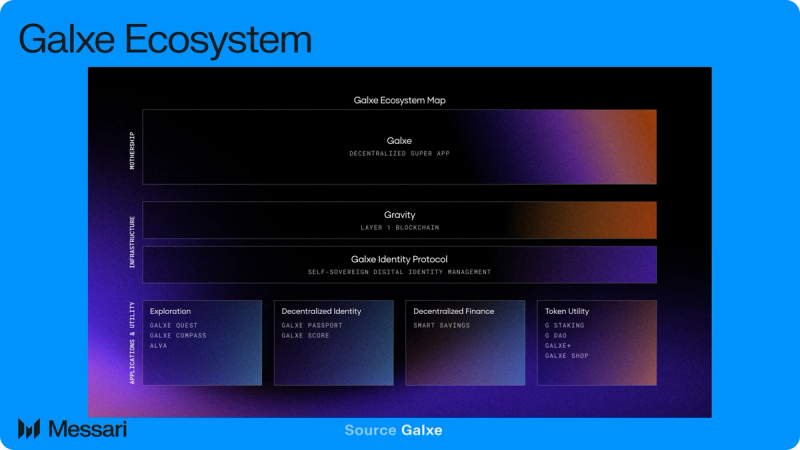
Galxe is a Web3 infrastructure and digital credential network, empowering Web3 experiences through modular, AI, digital identity, and blockchain technologies. Central to the Galxe ecosystem, termed the Super App, the Galxe Identity Protocol provides a foundational layer for secure and self-sovereign digital identity management. Alongside the protocol, Galxe’s product suite–Galxe Quest, Galxe Passport, Galxe Score, Galxe Compass, and AIva–supports the development of the next generation of Web3 applications.
Gravity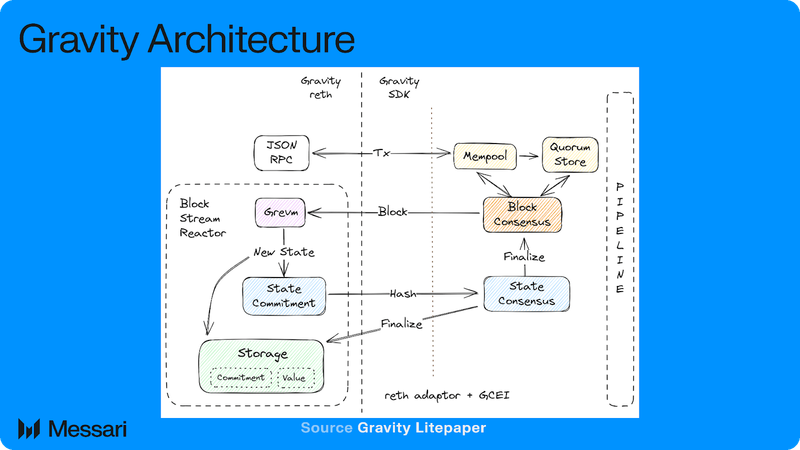
Gravity is an EVM-compatible Layer-1 Proof-of-Stake (PoS) blockchain that will support real-world adoption and enable an interconnected omnichain future. Built with a focus on scalability, speed, and security, Gravity will offer a throughput of 1 gigagas per second and achieve sub-second finality, making it capable of handling complex, resource-intensive applications without slowing down. By integrating Grevm (Gravity EVM) — a parallel EVM runtime based on revm — Gravity will improve smart contract execution speed and efficiency. Since the launch of Gravity’s Alpha Mainnet, the network has seen 25.2 million unique wallet addresses resulting in an average of 799,000 daily transactions. Additionally, over the past 30 days, it has facilitated 16.5 million transactions, ranking it eighth among all Validums and Optimums.
Gravity’s architecture is built on two key components: the Gravity SDK and the Gravity Reth execution layer. The Gravity SDK, derived from Aptos, uses a PBFT-family PoS consensus to optimize throughput and resource utilization. Gravity Reth operates as a pipelined execution layer based on reth, enabling parallel transaction execution, asynchronous state commitment, and efficient storage. These components are integrated via the Gravity Consensus Engine Interface (GCEI), which dynamically manages the pipeline stages based on network conditions. In this system, transactions are processed through an Ethereum-compatible JSON-RPC endpoint, batched by validators, and proposed by the leader before being executed in parallel by Grevm. The resulting state root is finalized through consensus and stored permanently.
Gravity’s security will be enhanced through restaking protocols like EigenLayer and Babylon, which fortify the network against potential threats while maintaining decentralization. This architecture provides security without sacrificing performance, making Gravity an attractive network for scalable applications. The chain’s cross-chain settlement protocols enable developers to define and settle transactions across multiple blockchains, facilitating interactions between ecosystems. This interoperability unlocks new opportunities for omnichain applications, improving user experiences by eliminating the complexities of cross-chain operations.
For end-users, Gravity aims to offer an experience that rivals traditional Web2 platforms, due to features like gas abstraction, which removes the need for users to bridge tokens between chains for multi-chain transactions. Gravity also supports intent-based transactions, allowing users to execute complex operations without needing to manage the underlying technical details, such as sourcing liquidity or navigating infrastructure-level complexities.
Galxe Identity Protocol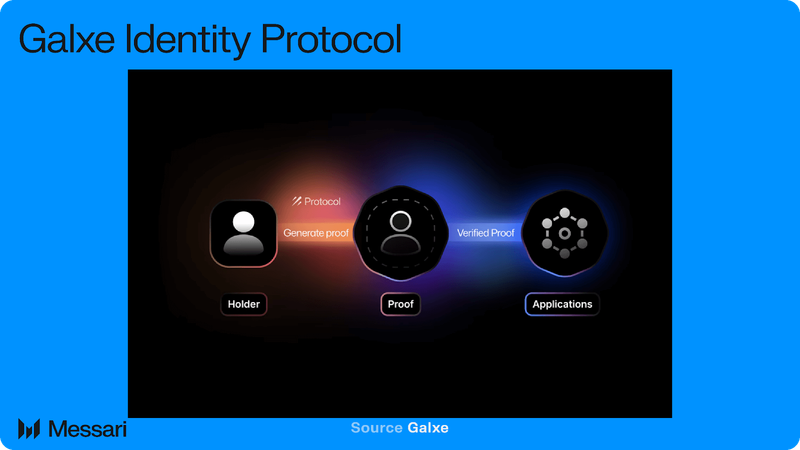
The Galxe Identity Protocol is a decentralized and permissionless identity infrastructure designed to empower users with complete control over their credentials and private data. By leveraging zero knowledge proofs (ZKPs), the protocol ensures that users can securely manage and verify their identities without exposing sensitive information. This infrastructure aims to redefine how credentials are issued, verified, and shared within the Web3 ecosystem, and since its launch, there have been a total of 225.7 million credential holders.
Credentials are essential proof of eligibility or achievement in both the physical and digital worlds. In Web3, credentials may represent a user's onchain activities, such as contributions to a liquidity pool, voting history, or campaign participation. However, in traditional Web2 platforms, these credentials are controlled by centralized entities like Google and Apple. This centralized approach limits user control, as these platforms determine how the data is used and shared. The Galxe Identity Protocol addresses this by offering a self-sovereign identity (SSI) model where users own and dictate the use of their credentials.
At the heart of the Galxe Identity Protocol is a series of smart contracts and an SDK (Software Development Kit) that developers can use to issue and authenticate credentials. The system defines four primary roles:
- Credential Holders: Individuals who own and selectively disclose credentials.
- Issuers: Entities that generate and issue verifiable credentials onchain.
- Verifiers: Entities that authenticate credentials based on programmable trust schemas.
- Credential Type Designers: Developers who create new credentials for specific use cases.
A credential schema within the protocol requires two elements: the context and the type. For example, verifying that a user is over 21 years old (context) could use a simple yes/no (boolean) credential type.
The protocol supports chain-agnostic components, ensuring broad compatibility across multiple blockchain networks. This flexibility allows users to connect different identities and generate ZKPs without compromising privacy. Potential use cases for this protocol include:
- Selective Disclosure: Users can prove specific details without revealing unrelated information. For instance, proving age eligibility for an alcohol purchase without disclosing their full ID information.
- Gaming Achievements: Gamers can own their in-game accomplishments, such as reaching a specific rank or defeating a boss, and use these credentials to unlock rewards in other games or receive targeted benefits.
- Social Media Identity: Users can retain control over their social media data, including followers and content. Instead of being exploited for advertising, they can verify their credentials and share them selectively.
The Galxe Identity Protocol also aims to solve the digital identity multiplicity problem, which means that users now have many different identities across each platform. The Galxe Identity Protocol tackles this challenge by allowing users to link these identities privately. For example, a user’s credentials earned on a DeFi protocol will be stored with those earned on an NFT protocol. Through ZKPs, users can consolidate their credentials and generate verifiable proofs without disclosing the connections between their accounts. This approach ensures that identity verification remains comprehensive yet privacy-preserving. Additionally, ZKPs ensure verification remains fast and scalable, even as credential types and user demand grow.
Galxe Passport
Galxe Passport, an application built with Galxe Identity Protocol, is a secure, privacy-centric reusable identity solution designed for the Web3 ecosystem that has amassed 978,000 total passport holders since its inception. It allows users to verify their KYC identity while maintaining full control over their personal data. By encrypting identity information with a user-defined password, Galxe ensures that no third party, including itself, can access the data without explicit user consent. Verified through Persona, users receive an onchain Soulbound Token (SBT) as proof of personhood, enabling easier trusted access in campaigns, IDO/INO platforms, on-ramp payment providers, and other Web3 applications requiring verification, thereby preventing Sybil attacks and eliminating redundant checks. Built on principles of security and transparency, Galxe Passport supports integration through the Galxe Identity Protocol SDK as well as Galxe ID SDK, offering a compliant and privacy-protecting solution for identity verification in the decentralized world.
Galxe Quest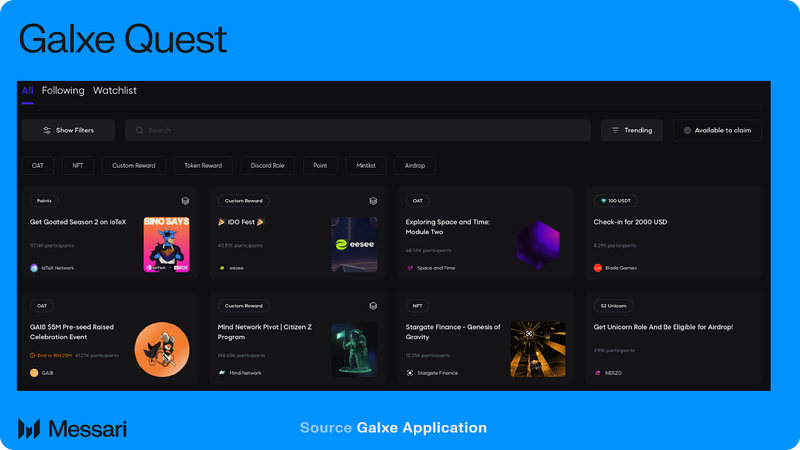
Galxe Quest has helped build and engage over 6,500 Web3 communities, including Optimism, Arbitrum, and Polygon. With a turnkey, no-code solution, Galxe Quest allows developers and brands to create reward-based loyalty programs, connecting them with a broad user base through interactive, onchain experiences.
Since its inception, Galxe Quest has had over 1.1 billion quests completed from 31 million unique addresses. In total, the platform has facilitated over 73,000 quest campaigns in collaboration with more than 6,500 partners.
Galxe Quest offers automated growth solutions that optimize user acquisition by combining onchain analytics with offchain interactions. This targeted approach helps projects attract the right audiences and expand their ecosystems effectively. Through Quest-to-Earn campaigns, newcomers are seamlessly converted into active users via educational content, quizzes, and interactive onchain tasks, promoting a deeper understanding of the project.
To ensure authentic engagement, Galxe Quest employs sybil-resistant credentials to prevent bot activity, fostering a community composed of real users. Strategic social media integrations and Galxe’s extensive network amplify brand visibility, while credential-based targeting helps projects connect with loyal supporters. Additionally, long-term loyalty programs provide continuous incentives, encouraging sustained user retention and stronger community bonds.
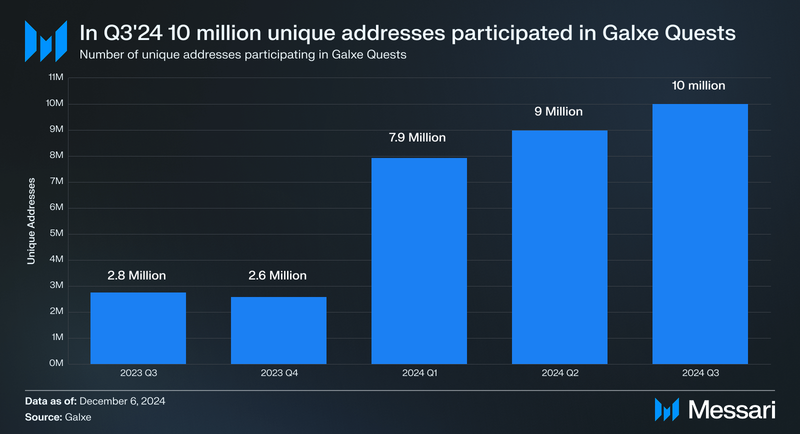
In total, Galxe has amassed 31 million unique addresses interacting with protocols via Galxe Quest. Since the beginning of the year, Galxe has seen constant user growth as the number of unique addresses participating in Galxe Quest increased from 2.6 million in Q4’23 to 10 million in Q3’24, a 287% increase. This increase was in line with the broader market trends as crypto interest increased throughout 2024.
An example of a Galxe quest was the March of the Beras campaign. According to a case study conducted by Galxe, Berachain’s campaign attracted over 8.5 million participants and generated 10.9 million visits in just 80 days. This strategic initiative led to significant increases in liquidity and community engagement, with Berachain growing to 930,000 followers on X and 470,000 members on Discord. Additionally, Berachain's liquidity on its exchange, BEX, surged to $25 billion in Total Value Locked (TVL), and staked governance tokens (BGT) reached $64.3 million.
Galxe Telegram Mini App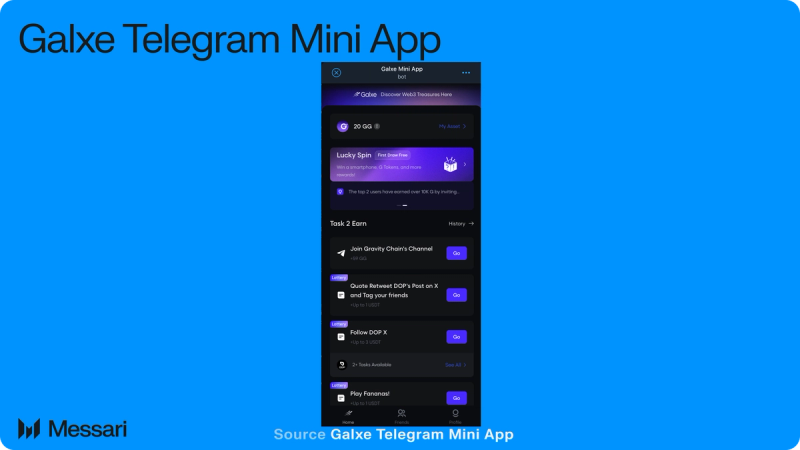
The Galxe Telegram Mini App helps onboard and engage Web3 communities within the Telegram environment. By offering an intuitive, Task-to-Earn platform, the Galxe Telegram Mini App empowers developers and brands to create interactive, reward-based experiences that reach millions of users in real-time, blending social engagement with decentralized exploration. Since its launch in November 2024, it has amassed 914,000 monthly users.
The Galxe Telegram Mini App streamlines user acquisition by combining task-driven interactions with accessible, familiar workflows. This approach enables projects to attract a wide range of participants, from newcomers to experienced crypto users, effectively expanding their reach. Through engaging quests, users are encouraged to complete actions such as wallet connections, social media tasks, and community participation, enhancing their understanding of Web3.
To ensure meaningful engagement, the app integrates sybil-resistant credentials, reducing bot activity and fostering an ecosystem of genuine users. By leveraging Telegram’s network and Galxe’s infrastructure, the Mini App amplifies project visibility and enables credential-based targeting, helping brands connect with dedicated supporters. Additionally, milestone-based rewards and prize incentives keep users motivated, driving long-term retention and stronger community bonds.
Galxe Compass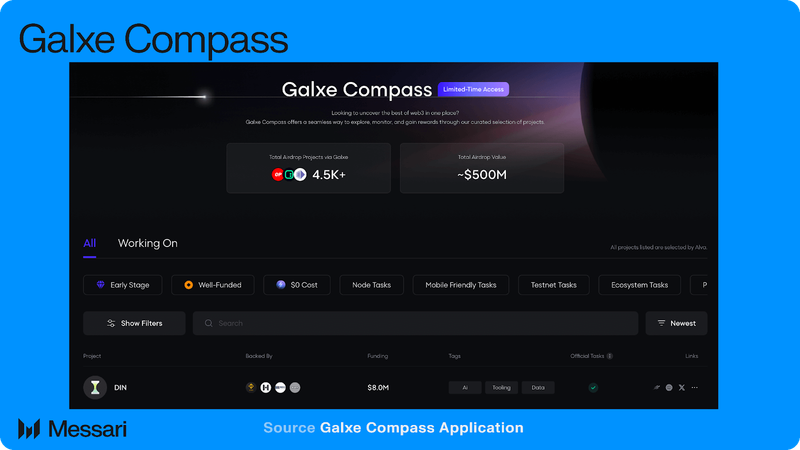
Galxe Compass is an AI-powered navigator for discovering and managing airdrop opportunities across Web3. This tool acts as a curated hub and watchlist, simplifying the process of identifying, tracking, and participating in airdrop campaigns. Since its inception, Galxe Compass has facilitated over 4,500 airdrop campaigns, distributing more than $500 million in tokens to users.
The Explore page offers detailed project insights, including investor information and task-specific guidance. Each project profile provides clear steps to complete tasks and estimated ROI, making participation straightforward for both new and experienced users. Compass also supports direct onchain interactions like staking, with future plans to add features like swaps and bridging.
Galxe Earndrop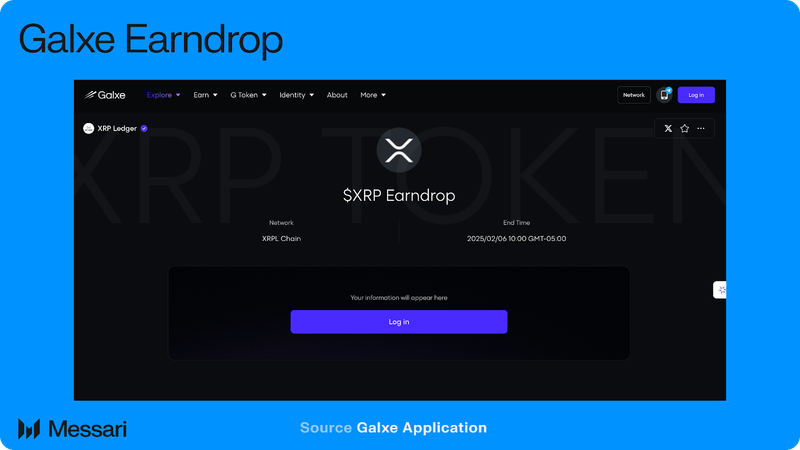
Earndrop is a next-generation token distribution tool that simplifies airdrops and reward claims for users and projects alike. Designed to eliminate the complexities of traditional airdrop campaigns, Earndrop provides an automated solution for delivering rewards without the need for custom claim pages, intricate configurations, or manual processes.
For projects, Earndrop removes the friction often associated with distributing rewards like airdrops or Token Generation Events (TGEs). By automating the process, it will ensure accuracy, transparency, and efficiency, enabling teams to focus on community growth and engagement.
For users, Earndrop offers a centralized hub where they can claim rewards from multiple projects effortlessly. Instead of navigating various platforms or searching for claim pages, users can log in, check eligibility, and collect tokens through a single, user-friendly interface.
Earndrop aims to revolutionize token distribution by delivering a smoother, more rewarding experience for the Web3 ecosystem.
Alva
Alva, an AI-powered research assistant, simplifies the often time-consuming process of crypto research for traders, investors, and explorers. Alva is available as an interactive Chatbot and a Browser Extension. By leveraging the GPT-4o language model, Alva synthesizes information and delivers real-time insights and analytics by ingesting information from official websites, news outlets, whitepapers, data sources, and social media. GPT-4o also allows Alva to retain a crypto-native knowledge base, enabling it to understand crypto-specific language.
With the ability to access vast amounts of crypto-specific knowledge through retrieval-augmented generation (RAG) and natural language processing (NLP), Alva can understand the data ingested and produce context-aware insights without having to provide additional data. Thus, it can process both structured (e.g., price data) and unstructured data (e.g., blogs and videos) for comprehensive analysis. With sentiment analysis, Alva synthesizes social media discussions and key opinion leader mentions to provide bullish or bearish signals.
Alva offers comprehensive market analysis by evaluating business metrics like TVL, fees, and user engagement to gauge project health, monitoring CEX transactions to infer sentiment from asset flows, and summarizing news for timely strategy adjustments. It leverages technical indicators (e.g., MACD, Connors RSI) for trading signals, tracks whale and VC wallet activity for market insights, analyzes social media sentiment to detect trends, and uses onchain data to assess blockchain metrics and market stability.
As Alva continues to evolve, it aims to refine its features to serve both casual users and experienced traders. Future developments include support for Galxe Quest, quiz assistance, wallet integration, and transaction execution, creating an all-in-one platform for managing research, learning, and trading in the Web3 ecosystem.
Galxe Loyalty PointsThe Galxe Loyalty Points System is an onchain solution designed to create, distribute, and manage loyalty points with the benefits of blockchain transparency, immutability, and security. Brands, developers, and event organizers can issue custom loyalty point tokens as ERC-20 tokens, that are fully verifiable and transferable onchain. This system enables streamlined earning, transferring, and managing of loyalty points while giving issuers full control over token minting, burning, and transferability. These customizable tokens help drive user engagement through efficient, blockchain-based loyalty programs.
Core features include customizable contracts for minting and burning loyalty points individually or in batches, transferability controls, and hooks for integrating custom logic such as rewards distribution or access control. Security is enhanced through pausable contracts, allowing admins to freeze transactions during maintenance or security issues. Use cases range from retail loyalty programs, event ticketing, and gaming rewards to community engagement initiatives. By leveraging the Galxe Loyalty Points System, projects can create flexible and transparent loyalty experiences that foster deeper user connections and sustained community engagement.
G Tokenomics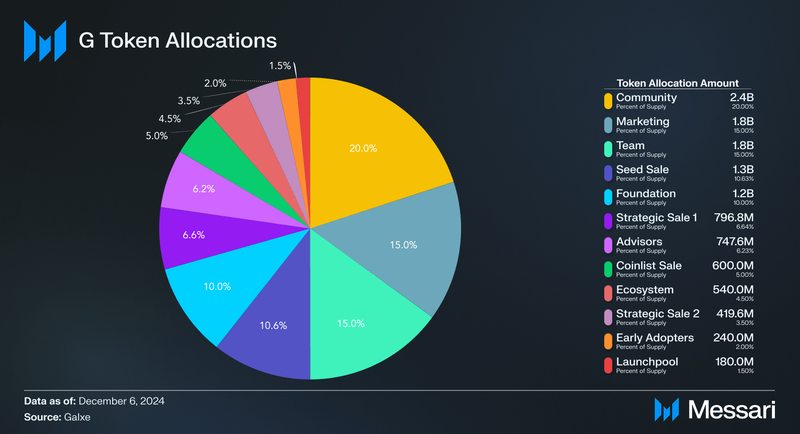
Galxe initially launched GAL as its utility token but underwent a token migration to G in July 2024 in which GAL is convertible to G at a 1:60 ratio, with a total supply of 12 billion G, distributed across multiple networks for accessibility: 10 billion G on Ethereum and 2 billion G on BNB Smart Chain, with plans to bridge tokens to Base. At launch, 7.2 billion G (60.3% of the total supply) were in circulation. The full breakdown of the token distribution is as follows:
- 1.5% to Launchpool (180 million G) – Fully unlocked on migration day.
- 2.0% to Early Adopters Rewards (240 million G) – Fully unlocked on migration day.
- 4.5% to Ecosystem (540 million G) – Fully unlocked on migration day.
- 5.0% to Coinlist Public Sale (600 million G) – Fully unlocked on migration day.
- 10.63% to Growth Backer Round 1 (Seed Sale) (1.3 billion G) – 58.3% unlocked on migration day, followed by 5 quarterly unlocks starting from August 5, 2024.
- 6.64% to Growth Backer Round 2 (Strategic Sale 1) (796.8 million G) – 63.3% unlocked on migration day, followed by 5 quarterly unlocks starting from August 5, 2024.
- 3.5% to Growth Backer Round 2 (Strategic Sale 2) (419.6 million G) – 63.3% unlocked on migration day, followed by 5 quarterly unlocks starting from August 5, 2024.
- 6.23% to Advisors & Partners (747.6 million G) – 63.3% unlocked on migration day, followed by 5 quarterly unlocks starting from August 5, 2024.
- 15.0% to Marketing (1.8 billion G) – 73.3% unlocked on migration day, followed by 4 quarterly unlocks starting from October 5, 2024.
- 10.0% to Foundation (1.2 billion G) – 58.8% unlocked on migration day, followed by 9 quarterly unlocks starting from September 5, 2024.
- 15.0% to Team (1.8 billion G) – 30.5% unlocked on migration day, followed by 50 monthly unlocks starting from August 5, 2024.
- 20.0% to Community (2.4 billion G) – 48.6% unlocked on migration day, followed by 35 monthly unlocks starting from August 5, 2024.
G intends to function as the native utility token on Gravity, while simultaneously powering the Galxe ecosystem. It will serve the following functions:
- Staking: G holders can stake their tokens to secure the Gravity network, ensuring long-term sustainability and decentralization. Stakers earn rewards and gain exclusive benefits from Galxe applications like Galxe Quest, Galxe Passport, Galxe Score, and Alva.
- Governance: G holders can participate in the G DAO, enabling them to propose and vote on decisions related to risk management, product development, and rewards.
- Transactions: Once Gravity Mainnet is live, G tokens will be used to pay transaction fees when users send transactions or interact with smart contracts on the network.
- Payments: G facilitates payments across the Galxe ecosystem for applications like Galxe Quest, Galxe Passport, Galxe Score, and Alva. It also supports Galxe Shop, Galxe Earn, and other services.
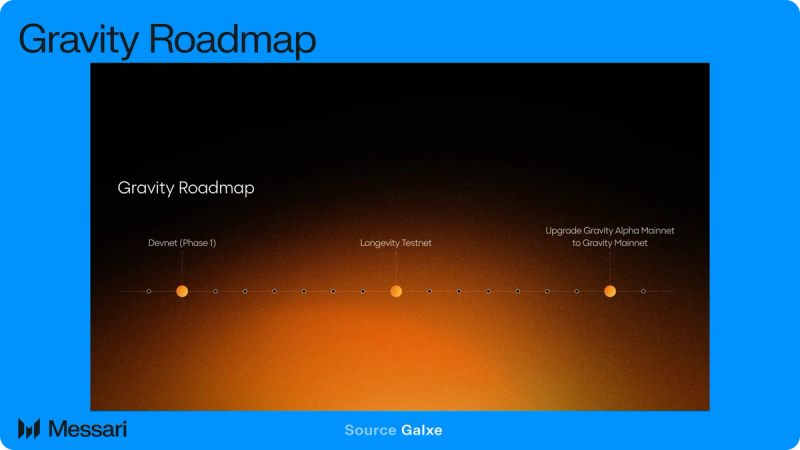
Gravity's Alpha Mainnet, powered by Arbitrum Nitro is live, with the L1 Devnet Phase 1 expected to launch in Q1’25, followed by the Longevity Testnet. The full mainnet is expected in Q4’25.
In December 2024, the G DAO approved a proposal to allocate a $5 million budget to the Developer Grant Program. This capital will fund strategic initiatives within the Gravity ecosystem, such as developers building apps on Gravity. The Gravity Ecosystem VC Alliance also committed $50 million to support projects building on Gravity. This ecosystem fund includes backing from venture capital firms like HashKey Capital, DAO5, Lattice, and Spartan Group.
Closing SummaryGalxe is leading the Web3 space as the largest community-building platform. As a leading Super App in the crypto space, Galxe is redefining digital identity and credential verification through its decentralized infrastructure, which has attracted over 31 million unique addresses and partnerships with over 6,500 projects. By using ZKPs for the Galxe Identity Protocol, users maintain self-sovereign identities, ensuring complete control over their data while enabling secure, interoperable verification across platforms. This approach overcomes the limitations of centralized Web2 identity solutions, offering a privacy-preserving alternative.
With Gravity, Galxe’s Layer-1 omnichain blockchain, the ecosystem provides scalability, speed, and cross-chain interactions. Gravity’s architecture supports real-world applications with parallel EVM execution and sub-second finality. Galxe’s product suite, including Galxe Passport, Galxe Quest, Galxe Score, and the AI-powered Alva, facilitates community engagement, identity verification, and real-time Web3 insights. The G token powers the ecosystem, supporting staking, governance, and transactions.
Galxe’s robust infrastructure positions it as one of the leaders in decentralized identity solutions. It aims to drive widespread Web3 adoption and community growth through continuous innovation and strategic investments.
- Home
- About Us
- Write For Us / Submit Content
- Advertising And Affiliates
- Feeds And Syndication
- Contact Us
- Login
- Privacy
All Rights Reserved. Copyright , Central Coast Communications, Inc.